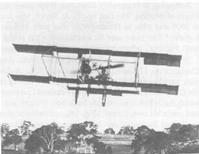


Chapter 7
I The First 100 Years 1788-1888
II Railways
III Motorised Vehicles
IV Aviation
i Local Inventions, Research, Design and Manufacture
ii The Development of Air Transport: The Trail Blazers
iii The Services
iv The Royal Flying Doctor Service
v Ground Aids and Safety Innovations
vi From Aviation to Modern Shipping
V Modern Shipping
VI Innovative Small Craft
VII Conclusion
VIII Acknowledgements
IX Contributors
References
Index
Search
Help
Contact us

Local Inventions, Research, Design and Manufacture
It is interesting to observe that, when the time is ripe for a given new technology, similar or identical inventions appear almost simultaneously in various countries. Thus it was becoming evident, by the turn of the century, that the solution to flight by heavier-than-air machines was approaching.In Germany, Lilienthal was experimenting with man-carrying gliders, in the United States, Langley and the Wright Brothers were busy with powered aircraft, in Russia, Tsiolkowsky was on the same track -and in Australia Lawrence Hargrave was experimenting with a range of devices leading to the solution of the problem of flight.
There is no doubt that Hargrave was at the forefront of flight technology at the time and that his efforts were hampered by the distance from his co-inventors in the Northern Hemisphere. His concentration on flapping flight, rather than on fixed wings led him, however, into a blind alley which, as far as flight is concerned, still remains as such. As it was, one of his models, a compressed-air-powered flapping wing machine weighing 2.53 Ibs flew a distance of 368 feet on 8 April, 1890. Hargrave spent, in fact, some five years, from 1888, on the development of suitable engines and, in 1889, invented what was probably the first rotary engine.[1]
Hargrave turned his attention to kites in 1893 and, in November, 1894, using four box kites, he was lifted clear off the ground and thus became the first Australian to become airborne in a heavier-than-air machine. Between 1895 and 1903 he built five free- flying machines, which he believed would have been capable of powered flight carrying a man, had a suitable engine been available.
Following in Hargrave's footsteps, three other Australians were active in the early stages of aviation. The first was G. A. Taylor, who founded the Aerial League of N.S.W. in 1909 and who, in December of that year, became the first Australian who flew in a glider.[2] The same year he established what could be termed 'Australia's First Aircraft Factory', where he constructed Hargrave-type box kites and gliders.
Whilst the first controlled flight in Australia appears to have been made by Fred Custance on 17 March 1910 at Bolivar, S.A., followed next day by Harry Houdini near Melbourne, it is to John Duigan of Victoria that belongs the honour of being the first Australian to fly in a locally designed powered aircraft.[3] Contrary to the legend, which made him a self-taught bush-boy, Duigan was a graduate engineer. He designed and made his own aircraft (Fig. 24), operating in almost complete isolation from contemporary European and Australian pioneers. The power plant he used was produced by J. E. Tilley, also to Duigan's design. Duigan, in his professional way, conducted many structural tests on components and then practiced, in an extended series of short hops, before he was confident that his machine was controllable. His first 'flight' of some 24 ft. took place on 16 July 1910. At that stage Duigan realised he needed more power from his engine and undertook modifications to his power plant. From 7 October 1910, he was in a position to fly longer distances, extending to some 200 yards in length. His maximum distance, in 1911 was some 1,000 yards.

People in Bright Sparcs - Custance, Fred; Duigan, John; Hargrave, Lawrence; Houdini, Harry; Schaetzel, Stanley S.; Taylor, G. A.; Tilley, J. E.
 |
Australian Academy of Technological Sciences and Engineering |  |
© 1988 Print Edition pages 503 - 504, Online Edition 2000
Published by Australian Science and Technology Heritage Centre, using the Web Academic Resource Publisher
http://www.austehc.unimelb.edu.au/tia/497.html